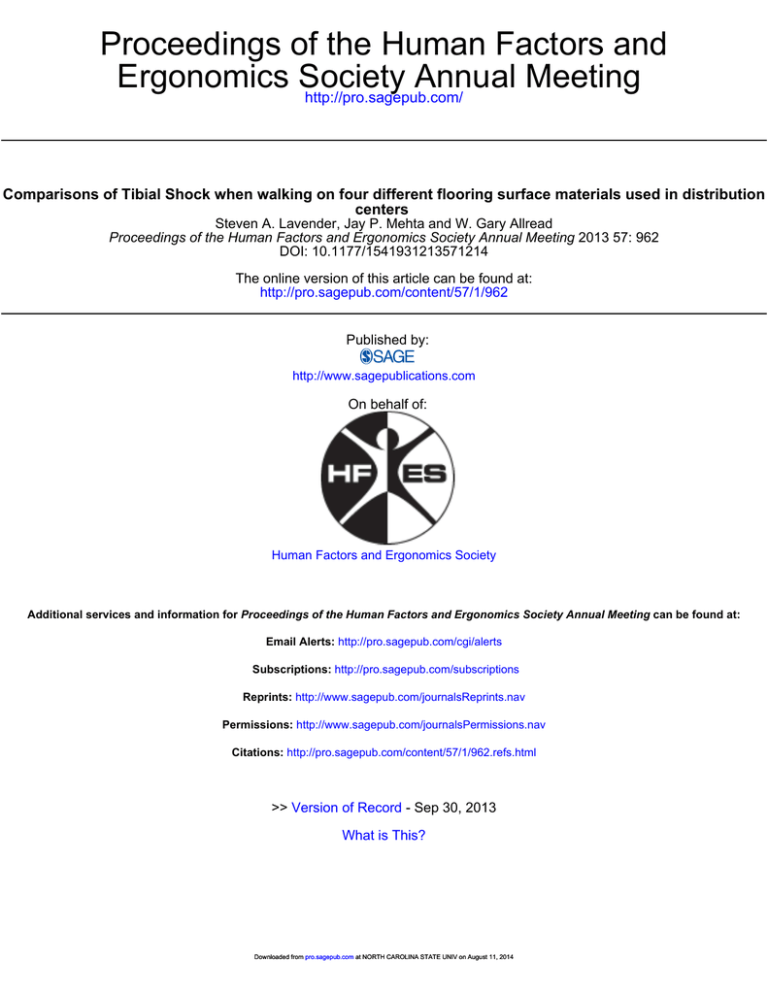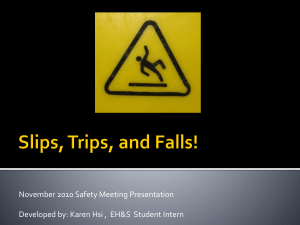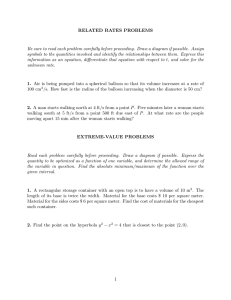
Proceedings of the Human Factors and
Ergonomics Society
Annual Meeting
http://pro.sagepub.com/
Comparisons of Tibial Shock when walking on four different flooring surface materials used in distribution
centers
Steven A. Lavender, Jay P. Mehta and W. Gary Allread
Proceedings of the Human Factors and Ergonomics Society Annual Meeting 2013 57: 962
DOI: 10.1177/1541931213571214
The online version of this article can be found at:
http://pro.sagepub.com/content/57/1/962
Published by:
http://www.sagepublications.com
On behalf of:
Human Factors and Ergonomics Society
Additional services and information for Proceedings of the Human Factors and Ergonomics Society Annual Meeting can be found at:
Email Alerts: http://pro.sagepub.com/cgi/alerts
Subscriptions: http://pro.sagepub.com/subscriptions
Reprints: http://www.sagepub.com/journalsReprints.nav
Permissions: http://www.sagepub.com/journalsPermissions.nav
Citations: http://pro.sagepub.com/content/57/1/962.refs.html
>> Version of Record - Sep 30, 2013
What is This?
Downloaded from pro.sagepub.com at NORTH CAROLINA STATE UNIV on August 11, 2014
PROCEEDINGS of the HUMAN FACTORS and ERGONOMICS SOCIETY 57th ANNUAL MEETING - 2013
962
Comparisons of tibial shock when walking on four different
flooring surface materials used in distribution centers
Steven A. Lavender1,2 Jay P. Mehta1 W. Gary Allread3
1
Integrated Systems Engineering
2
Othopaedics
3
Institute for Ergonomics
The Ohio State University
Copyright 2013 by Human Factors and Ergonomics Society, Inc. All rights reserved. DOI 10.1177/1541931213571214
Flooring surfaces can be made from concrete, bar grate, composite materials, or may be
covered with matting material. Anecdotal data suggested that surfaces made from wood
composite materials may be a more comfortable surface on which to work. The objective
of this study was to quantify differences in tibial shock as 16 people walked on concrete,
bar grate, a wood composite material, and a concrete surface covered with matting. An
accelerometer was attached to the right shin of volunteers who were asked to walk on
each surface. Significant differences across the four surfaces were observed when each
participant walked at their normal walking speed (p=.041) and when they walked at a
faster than normal pace (p=.023). These findings suggest that individuals working in
distribution centers, where extensive walking is part of the job, would possibly
experience less lower extremity discomfort on selected floor surfaces.
INTRODUCTION
Prolong standing at work has been associated
with lower extremity pain (Chandrasakaran, et al.,
2004; Hou and Shiao, 2006), which, in turn, is
predictive of early retirement (Rice et al., 2011).
Cham and Redfern (2001) showed that the level of
discomfort was affected by the type of surface upon
which one stands. Specifically, “softer” surfaces
have been associated with less subjectively
measured discomfort than harder surfaces (Redfern
and Cham, 2000). Likewise, Orlando and King’s
(2004) study found reduced reports of discomfort
among assembly line employees when working on
floor mats or using shoe insoles for a week,
compared to when they stood on a woodblock floor
for the same length of time.
Beyond matting and insoles, these findings
suggest that workers exposed to more compliant
flooring materials should also experience less
discomfort. One manufacturer of a wood composite
material used for mezzanine construction has
anecdotal reports from their customers that are
consistent with the above-referenced reports. This
manufacturer was interested in identifying if there is
an objective measure that can be used to
substantiate these subjective reports.
Selected studies in the gait analysis literature
have focused on quantifying “tibial shock” using
accelerometers affixed to the lower leg (Higginson,
2009; Whittle, 1999). The signals from skinmounted accelerometers have been shown to
provide reliable measures of the initial peak
acceleration at heel strike (Liikavainio et al., 2007)
and have been used to document the effectiveness
of cushioned insoles during running (Lake, 2000;
O’Leary et al., 2008). For example, O’Leary et al.
(2008) reported that the use of cushioned insoles
reduced the peak tibial accelerations during the
initial foot contact by an average of nearly 16
percent. These findings suggest that measurements
of the peak tibial accelerations may also be sensitive
to the differences in flooring material used in the
construction of mezzanines.
The aims of this work were: (1) to quantify the
number of steps taken in a typical day by
distribution center employees, and (2) to determine
if there were quantifiable differences in objective
biomechanical measures that could be used to
characterize different walking surfaces used in
warehouse and distribution center construction.
Specifically, this investigation compared the peak
tibial accelerations as people walked on concrete,
bargrate, matting, and a wood composite
mezzanine. Our hypothesis was that peak tibial
accelerations would be different across these four
surfaces.
Downloaded from pro.sagepub.com at NORTH CAROLINA STATE UNIV on August 11, 2014
PROCEEDINGS of the HUMAN FACTORS and ERGONOMICS SOCIETY 57th ANNUAL MEETING - 2013
METHODS
Participants. Sixteen volunteers, 11 males and
5 females, between the ages of 18 and 52 (mean =
36 years) participated in this study. All were
employed at a toy distribution facility. Mean height
and weight were 1.73 m (s.d.=0.10m) and 84 kg
(s.d.=23kg). BMI ranged from 20.9 to 50.2
(mean=27.7). All participants signed an IRB
approved consent document. Participants were
tested in this protocol in whatever footwear they
were wearing at the time which for all participants
was some type of athletic shoe.
Experimental Design. In the first part of the
study, a pedometer was provided to each of the
participants to record the number of steps taken
during a typical work day. In the second part of the
study, a repeated measures design was used in
which participants walked on a concrete, a bar
grate, a wood composite mezzanine, and mat
overlaying the concrete surface. The sequence of
surfaces was counterbalanced across subjects.
Instrumentation. A single axis accelerometer
(Vernier, model LGA-BTA) was attached to the
shin of each participant’s lower leg using a selfadhesive wrap (Figure 1) and aligned with the long
axis of the tibia. The sensor, sampled at 1000 Hz,
was connected to a data recorder and computer.
The computer was carried by one of the
investigators who
walked behind the
participants.
Figure 1. The
accelerometer
position on one of
the participants with
self-adhesive wrap.
Walking speed is an important covariate in this
study and was quantified by measuring the time
required to walk the 9.1 m test distance. An
auditory alarm, utilizing photo beams, was used to
signal the timing process (Figure 2).
Procedures. All participants reviewed and
signed informed consent documents approved by
963
The Ohio State University’s Institutional Review
Board. The accelerometer was positioned on the
anterior or anterior lateral aspect of the tibia. The
exact position was determined by where the
investigator responsible for instrumentation
believed the most rigid attachment to the bone could
be attained. The type of shoes worn by each
participant was noted.
Participants were instructed to walk at three
different speeds on each flooring type:
1. At their normal walking pace;
2. At a slower-than-normal but comfortable
pace; and
3. At a faster-than-normal pace.
Each condition was repeated twice, first walking
away from the original starting point and then
returning to the original starting point. Prior to
collecting data on each surface, the participant did a
practice walk in which they walked the full distance
away from and returning to the starting point. This
practice was used to familiarize the participant with
the feel of the instrumentation.
Data Analysis. This approach yielded two trials
in which data were obtained from each heel strike
from the instrumented leg within the 9.1 m walking
zone (~5 samples), for each combination of walking
speed and flooring condition. At each walking
speed, the high and low tibial accelerations were
removed in case unusual steps were taken, and the
remaining accelerations were averaged. These
averaged tibial accelerations, two from each
walking speed, were used to develop a regression
function for each individual and flooring condition
combination. The purpose of these regression
functions was to obtain the tibial accelerations for a
specific floor surface and walking speed for each
individual participant that could be used in the
overall data analysis using an ANOVA. For each
participant, the average normal walking speed
across the flooring conditions was calculated and
then entered in these subject and surface specific
regression functions to obtain the tibial
accelerations values for each surface at the specified
walking speed. This way the floor type
comparisons of the tibial acceleration data were
independent of any potential differences in the
walking speed across the four surfaces.
Downloaded from pro.sagepub.com at NORTH CAROLINA STATE UNIV on August 11, 2014
PROCEEDINGS of the HUMAN FACTORS and ERGONOMICS SOCIETY 57th ANNUAL MEETING - 2013
Photobeam –
Auditory signal
Figure 2. The data
collection process had
Stopping
participants walk at 3
point
X different speeds on
each flooring surface.
Photobeam –
Auditory signal
Starting
point
Data Collection Section
X
30000
R=Replenish
R R R R P P R P P R P P P P P
P=Picker
25000
22
21
p= 0.041
20
Acceleration (m/s^2)
RESULTS
Figure 3 shows the number of steps taken by the
participants during a typical shift. The participants
were either “pickers” or “replenishers.” On average
these distribution center workers take 18,860 steps
per day.
The means of the peak acceleration values when
walking at each subject’s average normal speed and
when walking 15 percent faster than their normal
speed are shown in Figure 4. At both walking
speeds the there were significant differences in the
tibial acceleration across the four floor surfaces
tested. The effect was stronger with the faster
walking speed. Given the exploratory nature of
this work, a least-squared difference test was used
to evaluate differences between flooring conditions.
For both walking speeds, these post-hoc analyses
indicated that the floor mat on concrete and the
wood composite resulted in lower tibial shock
values than when walking on bar grate.
19
18
17
16
15
14
13
12
11
10
Concrete+Mat
Wood Composite
Concrete
Bar Grate
Floor Type
(a) “Normal” speed
28
27
26
Acceleration (m/s^2)
Using the same subject and flooring condition
specific regression models, the tibial acceleration
values when walking 15 percent faster than the
subject’s average normal walking speed were
obtained, to evaluate the effect of more hurried
working conditions. The fifteen percent value was
selected because every participant walked at least
15 percent faster when instructed to walk “faster
than normal” and therefore was within the range of
each subject specific regression functions relating
walking speed to tibial acceleration.
The resulting data were analyzed using a within
subjects analysis conducted with SPSS.
Number of Steps Taken
10
3 feet
m
309.1
feet m
10
3 feet
m
964
p= 0.023
25
24
23
22
21
20
19
18
17
# of Steps
Average
+1 std
-1 std
+2 std
-2std
20000
15000
10000
16
Concrete+Mat
Wood Composite
Concrete
Bar Grate
Floor Type
(b) 15% Faster than “Normal” speed
5000
0
6
4
5 10 11 14 16 2 15 13 8
3
7
1
9
Participant ID
Figure 3. The number of steps taken by the 15 of the 16
participants sorted in increasing order. The “R” or “P”
signifies the job title
Figure 4. The mean of the peak tibial accelerations (tibial
shock values) across subjects when the subjects walked at
their normal walking speed (a) and when they walked
15% faster than normal. The horizontal lines above the
bars indicate conditions that were not statistically
different using Least Squared Difference test.
Downloaded from pro.sagepub.com at NORTH CAROLINA STATE UNIV on August 11, 2014
PROCEEDINGS of the HUMAN FACTORS and ERGONOMICS SOCIETY 57th ANNUAL MEETING - 2013
965
DISCUSSION
The tibial acceleration findings presented here
suggest there are differences in tibial shock across
different flooring surfaces used in distribution
centers. The magnitude of the significant
differences with this limited sample size was
between 7 and 10 percent, with the differences
becoming slightly larger at the faster walking speed.
In distribution center environments people often
move a hurried pace as their work output is often
continuously monitored by the warehouse
management system.
employees typically work. These findings suggest
there is the potential for reduced cumulative loading
of the lower extremities when working on wood
composite mezzanine surfaces or matted surfaces,
particularly if one works at a hurried pace. Further
study is needed to determine if these findings
translate to reduced lower extremity discomfort and
ailments.
One also needs to consider these results in the
context of daily exposure. Even with a modest .6 m
stride length this translates in to more than 11 km
traveled. If we focus on the product selectors who
take more steps than the replenishers, the mean
number of steps jumps to 21,000 steps per day, the
distance increases to 12.6 km, again assuming a
modest .6 m stride length. The small reduction in
tibial shock with this quantity of steps could
represent a significant reduction in cumulative
lower extremity load exposures. These data suggest
that designers of mezzanine surfaces should
consider the use wood composite materials over
using bar grate or concrete surfaces. Likewise,
there is a trend that supports the use of mats on
concrete ground level surfaces. However,
epidemiologic investigations will be required to
determine if these results correlate with differences
in lower extremity discomfort and pain associated
with extended walking during the workday.
REFERENCES
Cham R, Redfern MS. (2001). Effect of flooring on
standing comfort and fatigue. Human Factors,
43:381-91.
We also expected that the compliant soles of the
athletic shoes would potentially mask differences
across floor types. But even with these compliant
shoes we still see small effects. We had no way to
assess the status of these athletic shoes as to their
level of wear. Given people work in these athletic
shoes on a daily basis, the effectiveness of the
cushioning may be reduced relative to when the
shoes were new, therein making flooring
compliance more important.
CONCLUSIONS
Overall these data supported our hypothesis in
that the peak tibial accelerations differed across
flooring surfaces on which distribution center
ACKNOWLEDGEMENT
This research was supported by a grant from
Cornerstone Specialty Wood Products, LLC.
Chandrasakaran A, Chee HL, Rempal KG, Tan GL.
(2003). The prevalence of musculo¬skeletal
problems and risk factors among women
assembly workers in the semiconductor
industry. Medical Journal of Malaysia,
58(5):657-666.
Higginson BK. (2009) Methods of running gait
analysis. Current Sports Medicine Reports,
8:136-141.
Hou JY, Shiao JS. (2006). Risk factors for
musculoskeletal discomfort in nurses. Journal of
Nursing Research, 14(3):228-36.
Lake, M. (2000). Determining the protective
function of sports footwear. Ergonomics, 43,
1610 -1621.
Liikavinio T, Bragge T, Hakkarainen M, Jurvelin
JS, Karjalainen PA, Arokoski JP. (2007).
Reproducibility of loading measurements with
skin mounted accelerometers during walking.
Archives of Physical Medicine and
Rehabilitation, 88:907-915.
O’Leary, K., Anderson Vorpahl, K., Heiderscheit,
B. (2008). Effect of cushioned insoles on impact
forces during running. Journal of the American
Podiatric Medical Association, 98, 36-41.
Downloaded from pro.sagepub.com at NORTH CAROLINA STATE UNIV on August 11, 2014
PROCEEDINGS of the HUMAN FACTORS and ERGONOMICS SOCIETY 57th ANNUAL MEETING - 2013
Orlando AR, King PM. (2004). Relationship of
demographic variables on perception of fatigue
and discomfort following prolonged standing
under various flooring conditions. Journal of
Occupational Rehabilitation, 14(1):63-76.
Redfern MS, Cham R. (2000) The influence of
flooring on standing comfort and fatigue.
American Industrial Hygiene Association
Journal, 61(5):700-8.
Rice NE, Lang IA, Henley W, Melzer D. (2011)
Common health predictors of early retirement:
findings from the English Longitudinal Study of
Ageing. Age and Ageing, 40(1):54-61.
Whittle MW (1999) Generation and attenuation of
transient impulsive forces beneath the foot: a
review. Gait and Posture, 10:264-275.
Downloaded from pro.sagepub.com at NORTH CAROLINA STATE UNIV on August 11, 2014
966







